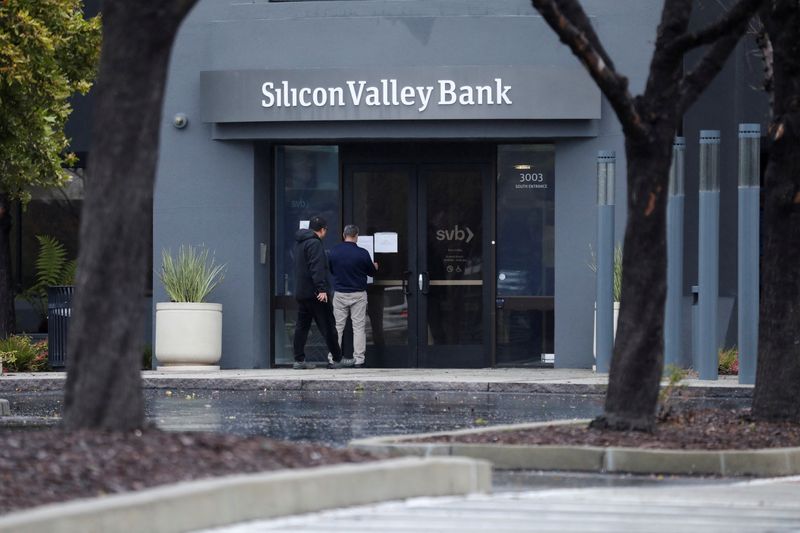By Barani Krishnan
Investing.com - With less than 24 hours to the release of America’s most influential indicator on inflation and the potential rate hike that could trigger, oil prices tumbled for another reason: Worries over a U.S. banking debacle.
Crude prices tumbled as much as 4% Monday before settling down more than 2% despite financial regulators saying they have acted to contain fallout from the collapse of Silicon Valley Bank, one of the country’s top 20 lenders. The Biden administration also has assured there won’t be a relapse of the financial crisis from 15 years ago.
New York-traded West Texas Intermediate, or WTI, crude settled down $1.88, or 2.4%, at $74.80 a barrel. It earlier sank 4% to reach $72.33. Its low prior to that was $70.25, reached on Dec. 12.
Technical charts pointed to a further downside, notwithstanding Tuesday’s inflation data and release of the government weekly report on oil inventories on Wednesday.
“Selling pressure could continue to push WTI towards $71.50 and $70.50,” said Suinil Kumar Dixit, chief technical strategist at SKCharting.com.
“As $77.30 acts as resistance, oil slips to horizontal support areas of $72.30, followed by a reactive bounce back from the lows aiming at $74.90.”
The tumble in crude prices came ahead of Tuesday’s key Consumer Price Index, or inflation, reading which will likely decide whether the Federal Reserve goes with a 25-basis point, or 50-bps, hike at its March 22 rate decision.
The CPI is expected to have expanded 6% year on year in February from 6.4% in January and 0.4% for the month versus a previous 0.5%.
Core CPI, a reading that strips out volatile food and energy prices, is forecast to have risen 5.5% for the year to February from the previous annual reading of 5.6%. Month-on-month, the core number is expected to be flat at 0.4%.
The government will ensure the bank deposits of Americans remain safe and the country does not experience another financial crisis, President Joe Biden told reporters at the White House.
“No losses of a dime … No losses will be borne by the taxpayers,” the president said. “The money will come from the fees that banks pay into the Federal Deposit Insurance [Corporation, or FDIC]. Because of the actions taken by regulators, every American should feel confident, their deposits will be there if and when they need them.”
Biden also said he was going to request Congress to review and strengthen post-financial crisis banking laws that were loosened by the previous administration, “to make sure that the crisis we saw in 2008 would not happen again.”
The latest U.S. banking crisis unfolded after investors yanked $42 billion in deposits from Silicon Valley Bank, the largest U.S. lender to fail since Washington Mutual collapsed in 2008 at the height of the financial crisis that year.
SVB provided financing for almost half of U.S. venture-backed technology and health care companies. At the end of 2022, the bank said it had $151.5 billion in uninsured deposits, $137.6 billion of which was held by U.S. depositors. Its total assets as of the end of last year was $209 billion.
The FDIC also took control of Signature, which had $110.36 billion in assets and $88.59 billion in deposits at the end of last year, according to New York state's Department of Financial Services.
Biden said the FDIC protection for depositors at SVB and Signature will not be extended to investors and the management at the collapsed banks, which he accused of excessive risk-taking.
“The management of these banks will be fired,” Biden said. “If the bank is taken over by FDIC, the people running the bank should not work there anymore. Investors in the banks will not be protected. They knowingly took a risk and when the risk didn't pay off, investors lose their money. That's how capitalism works and so forth. But there are very important questions of how these banks got into the circumstances. In the first place, we must get the full accounting of what happened, and why those responsible can be held accountable..”
Since the crisis broke, both regulators and the banking industry were working to contain it, reports said.
The bank, viewed as the next to fall – First Republic – secured additional financing from JPMorgan Chase & Co (NYSE:JPM) at the weekend, resulting in $70 billion in unused liquidity, firepower it could use to respond to potential customer withdrawals.
